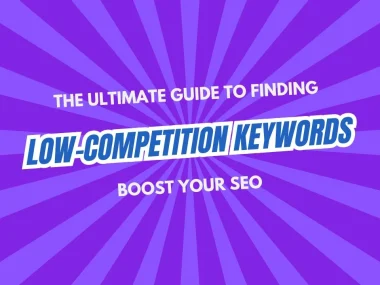Avoiding common SEO mistakes can significantly improve your Google rankings. Focus on these critical areas to optimize your website.
SEO is crucial for driving organic traffic to your website. Many websites fail to rank well due to avoidable errors. Prioritizing SEO best practices helps you achieve better visibility on search engines. This blog post covers ten common SEO mistakes that can hinder your ranking.
Avoiding these pitfalls will improve your search engine performance and user experience. From keyword stuffing to neglecting mobile optimization, each mistake can cost you valuable traffic. Implementing the right strategies ensures your content reaches its intended audience. Start optimizing your site today for better Google rankings and increased organic traffic.
Ignoring Keyword Research
One of the biggest SEO mistakes is ignoring keyword research. Keywords are crucial for getting noticed by search engines. Without proper keyword research, your content won’t reach your target audience. Let’s dive into why keywords are important and the tools you can use for research.
Importance Of Keywords
Keywords are the terms people search for on Google. They help search engines understand your content. Using the right keywords improves your site’s visibility. This drives more traffic and increases your rankings.
Choosing relevant keywords is crucial. It connects you with the right audience. Without the correct keywords, your content may get lost online.
Effective keyword research helps you understand what your audience wants. This allows you to create content that meets their needs.
Tools For Research
Several tools can help you find the best keywords. These tools make the research process easier and more effective.
- Google Keyword Planner: This free tool helps you find popular keywords. It shows search volumes and competition levels.
- SEMrush: A comprehensive tool that offers keyword suggestions and competitor analysis.
- Ahrefs: This tool provides in-depth keyword data. It also shows backlinks and traffic estimates.
- Ubersuggest: A user-friendly tool that gives keyword ideas and content suggestions.
Use these tools to identify relevant keywords. Make sure to include them naturally in your content. This will help improve your Google rankings and attract more visitors.
| Tool | Features |
|---|---|
| Google Keyword Planner | Search volumes, competition levels |
| SEMrush | Keyword suggestions, competitor analysis |
| Ahrefs | In-depth keyword data, backlinks, traffic estimates |
| Ubersuggest | Keyword ideas, content suggestions |
Overusing Keywords
Overusing keywords is a common mistake in SEO. Many believe that more keywords mean better rankings. This practice can hurt your Google rankings. Google values relevant content over keyword quantity. Let’s dive into two key aspects: Keyword Stuffing and Optimal Keyword Density.
Keyword Stuffing
Keyword stuffing involves overloading a page with keywords. This can make the content unreadable. Google recognizes this tactic and penalizes it. Aim for natural-sounding sentences. Avoid repeating the same keyword excessively.
Here are some examples of keyword stuffing:
- Repeating the same word in every sentence.
- Using keywords in places where they don’t fit naturally.
- Adding keywords in lists or tables without context.
Instead, focus on creating valuable content. Use synonyms and related terms. This makes the content more engaging and readable.
Optimal Keyword Density
Optimal keyword density refers to the perfect balance of keywords. Too many keywords can lead to penalties. Too few can miss ranking opportunities. Aim for a keyword density of 1-2%.
| Content Length | Keyword Count |
|---|---|
| 100 words | 1-2 keywords |
| 500 words | 5-10 keywords |
| 1000 words | 10-20 keywords |
Use keywords in titles, headers, and the first paragraph. Spread them naturally throughout the content. Avoid forcing keywords where they don’t fit. This keeps the content reader-friendly and engaging.
Remember, quality content trumps keyword quantity. Provide value to your readers. Google will reward you with better rankings.
Neglecting Mobile Optimization
Many website owners forget about mobile users. This can hurt their Google rankings. Mobile optimization is crucial today. Most people use their phones to browse the internet. If your site isn’t mobile-friendly, you might lose visitors. Below are some key points on mobile optimization.
Mobile-friendly Design
A mobile-friendly design makes your site easy to use on phones. Keep these tips in mind:
- Use large buttons for easy tapping.
- Ensure text is readable without zooming.
- Optimize images so they load quickly.
Visitors should navigate your site easily. A clean, simple design works best. Avoid clutter and keep it user-friendly. This will keep visitors on your site longer.
Responsive Layouts
Responsive layouts adapt to any screen size. Whether it’s a phone, tablet, or desktop, your site should look good. Use flexible grids and layouts. This makes sure everything fits perfectly on any device.
Here are some key elements for responsive design:
- Flexible images that resize with the screen.
- Media queries to apply styles based on device characteristics.
- Fluid grids that use relative units like percentages.
Responsive layouts improve user experience. They also help improve your Google rankings. Remember, Google favors mobile-friendly sites.
| Feature | Description |
|---|---|
| Large Buttons | Easy to tap on mobile screens |
| Readable Text | No need to zoom in |
| Optimized Images | Fast loading times |
| Flexible Images | Resize with the screen |
| Media Queries | Apply styles based on device |
| Fluid Grids | Use relative units like percentages |
By focusing on mobile optimization, you can improve your site’s performance. This will lead to better Google rankings and happier visitors.
Skipping Meta Descriptions
Many website owners neglect meta descriptions. This is a crucial SEO mistake. Meta descriptions provide a summary of your page content. They help search engines understand your page. Skipping meta descriptions can hurt your Google rankings.
Crafting Meta Descriptions
Crafting effective meta descriptions is essential for better SEO. A good meta description should be under 160 characters. It should include your primary keyword. It must also be engaging and relevant to the page content.
Here are some tips for crafting meta descriptions:
- Include your primary keyword.
- Keep it under 160 characters.
- Make it engaging and relevant.
- Use a call to action.
Impact On Click-through Rates
Meta descriptions significantly impact click-through rates (CTR). A well-crafted meta description can attract more clicks. Higher CTR can lead to better Google rankings.
Here is an example of a good meta description:
Compare this to a poor meta description:
The first example is clear, engaging, and includes a call to action. The second example is vague and less engaging.
Skipping meta descriptions can lead to lower CTR and poor rankings. Crafting effective meta descriptions can improve your SEO performance.
Poor Quality Content
Creating high-quality content is crucial for achieving better Google rankings. Poor quality content can harm your website’s SEO. It can lead to higher bounce rates, lower engagement, and reduced credibility. This section will explore common mistakes related to poor quality content and provide tips on how to avoid them.
Content Relevance
Content relevance is key to engaging your audience. Ensure your content matches your audience’s search intent. Use keywords naturally and don’t stuff them. Focus on providing valuable information that answers questions. Avoid writing off-topic or generic content.
Use the following table to understand content relevance better:
| Content Type | Relevance |
|---|---|
| Blog Posts | Highly relevant, addresses specific questions |
| Product Descriptions | Detailed, includes keywords and benefits |
| News Articles | Timely, includes current events and trends |
Engaging Writing
Engaging writing keeps readers on your page. Use short sentences and simple words. Incorporate bullet points and numbered lists. Break up text with headings and subheadings. Add visuals like images and videos to enhance the content. Avoid long paragraphs and complex jargon.
- Use active voice
- Keep paragraphs short
- Include visuals
- Use bullet points and lists
Following these tips ensures your content is both relevant and engaging. This helps improve your Google rankings.
Ignoring Backlinks
Backlinks remain a crucial part of SEO strategies. Many ignore them, leading to poor rankings. Understanding how to manage backlinks can significantly improve your site’s visibility on Google.
Quality Over Quantity
Many think more backlinks mean better rankings. This isn’t true. Google values quality over quantity. A few high-quality backlinks can boost your SEO more than numerous low-quality links.
High-quality backlinks come from authoritative sites. They hold more weight in Google’s algorithms. A single backlink from a reputable site can outperform dozens from lesser-known sites.
| Quality Backlinks | Low-Quality Backlinks |
|---|---|
| From trusted sources | From unknown or spammy sites |
| Relevant to your content | Unrelated to your niche |
| Boosts credibility | Can harm your site’s reputation |
Building Natural Links
Google favors natural links. These are links that come naturally, without manipulation. Avoid tactics like buying links or participating in link schemes.
Here are ways to build natural links:
- Create high-quality content that others want to link to.
- Engage with your audience through social media and forums.
- Write guest posts for reputable blogs in your niche.
By focusing on quality and building natural links, you improve your site’s authority and ranking. Ignoring these principles can lead to poor SEO performance.
Slow Website Speed
One of the most critical SEO mistakes is slow website speed. A slow website can frustrate users and push them away. Google also considers page speed as a ranking factor. Hence, optimizing your website speed is essential for better rankings.
Speed Optimization Tools
Various tools can help you optimize your website speed. These tools identify slow-loading elements and offer solutions.
- Google PageSpeed Insights: This tool analyzes your website and provides speed scores.
- GTmetrix: This tool offers detailed reports on your website’s performance.
- Pingdom: This tool tests your site and shows its load time.
Using these tools helps you understand where your website lags. They provide actionable insights to improve speed.
Impact On User Experience
A slow website negatively impacts user experience. Users expect pages to load quickly. If a page takes too long, users leave. This increases your bounce rate.
Google notices this behavior. Websites with high bounce rates rank lower. A faster website keeps users engaged longer. They are more likely to explore other pages. This improves your overall SEO performance.
To sum up, a fast website leads to happy users and better rankings. Use speed optimization tools to identify and fix issues. Ensure your website loads quickly to keep users satisfied and improve your SEO.
Not Using Analytics
Not using analytics is a big mistake in SEO. Analytics help track website performance. They show what works and what doesn’t. Ignoring analytics means missing key data. This data helps improve search rankings.
Tracking Performance
Tracking performance is crucial for SEO success. Google Analytics offers detailed insights. It shows visitor behavior, traffic sources, and popular content. This helps understand what users like. Use this data to improve your site.
Here’s a table showing the key metrics to track:
| Metric | Description |
|---|---|
| Organic Traffic | Visitors from search engines |
| Bounce Rate | Percentage of visitors leaving after one page |
| Session Duration | Average time spent on site |
| Conversion Rate | Percentage of visitors completing a goal |
Adjusting Strategies
Use analytics to adjust strategies. If a page has a high bounce rate, improve its content. If a page gets lots of organic traffic, create similar content. Analyze session duration to understand user engagement.
Follow these steps to adjust strategies:
- Identify pages with high bounce rates.
- Improve content on those pages.
- Check pages with high organic traffic.
- Create similar high-quality content.
- Monitor session duration for engagement clues.
Ignoring analytics hinders SEO growth. Use analytics to make informed decisions. This boosts your Google rankings effectively.
Ignoring Local SEO
Ignoring Local SEO is a common mistake that businesses make. Local SEO helps attract nearby customers. It ensures your business appears in local search results. Ignoring this can lead to missed opportunities and lower rankings.
Local Keywords
Using local keywords is crucial for targeting nearby customers. These keywords include location-specific terms like city names and neighborhoods. For example, “best pizza in New York” targets a specific location. Add these keywords naturally in your content. This helps search engines understand your business location. It also improves your chances of appearing in local searches.
Here’s a quick guide to using local keywords:
- Identify the main services or products you offer.
- Add your city or neighborhood to these keywords.
- Use tools like Google Keyword Planner for local keyword ideas.
Google My Business
Google My Business (GMB) is a free tool from Google. It helps manage your online presence. Creating and optimizing a GMB profile is essential for local SEO. A well-optimized GMB profile improves your chances of appearing in local searches. It also provides valuable information to potential customers.
Here’s how to optimize your GMB profile:
- Claim your business: Ensure your business profile is claimed and verified.
- Complete all information: Add accurate details like address, phone number, and hours of operation.
- Add high-quality photos: Include images of your business location, products, and services.
- Collect reviews: Encourage satisfied customers to leave positive reviews.
- Respond to reviews: Engage with customers by responding to their feedback.
By focusing on these areas, you can enhance your local SEO efforts. This, in turn, can lead to better Google rankings and more local customers.
Neglecting Social Media
Many businesses overlook the power of social media. This mistake can hurt your Google rankings. Social media platforms provide valuable opportunities for increased visibility and engagement. Ignoring them means missing out on potential traffic.
Social Signals
Social signals refer to the activities on social media that indicate popularity and engagement. These include likes, shares, comments, and retweets. Search engines use these signals to determine the relevance and authority of your content.
| Social Signal | Impact on SEO |
|---|---|
| Likes | Shows content popularity |
| Shares | Increases content reach |
| Comments | Indicates user engagement |
| Retweets | Boosts content visibility |
Ignoring social signals can lead to lower search rankings. Your content must be visible and engaging on social media.
Integrating Social Media
Integrate social media into your SEO strategy. This integration increases your content reach and engagement. Here are simple steps to integrate social media:
- Create social media profiles for your business.
- Regularly post content on these platforms.
- Engage with your audience by responding to comments.
- Encourage users to share your content.
- Use social media buttons on your website.
By integrating social media, you enhance your content’s visibility. This leads to better Google rankings.
Frequently Asked Questions
What Are Common SEO Mistakes?
Common SEO mistakes include keyword stuffing, poor content quality, ignoring meta tags, and not optimizing for mobile. These errors can harm your rankings.
How Does Keyword Stuffing Affect SEO?
Keyword stuffing leads to poor user experience and search engines may penalize your site. This results in lower rankings.
Why Is Mobile Optimization Important For SEO?
Mobile optimization is crucial as many users browse on mobile devices. Google prioritizes mobile-friendly sites in its rankings.
Can Poor Content Quality Hurt SEO Rankings?
Yes, poor content quality can hurt SEO. Google favors high-quality, relevant content that provides value to users, affecting rankings.
Conclusion
Avoiding common SEO mistakes can significantly boost your Google rankings. Focus on quality content, proper keyword usage, and user experience. Regularly update your strategies to stay competitive. Implement these tips to enhance your website’s visibility. Consistent effort leads to better search engine performance and increased traffic.
Prioritize SEO best practices for long-term success.











